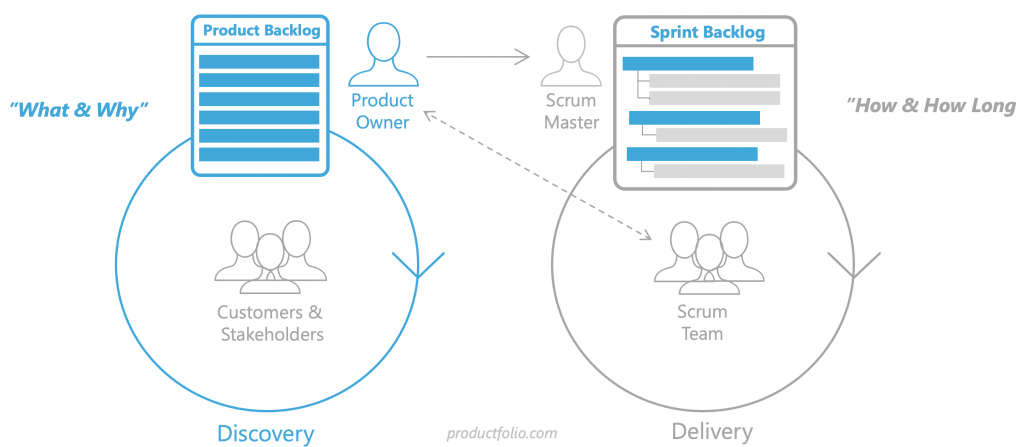What is Scrum?
Scrum is an Agile project management framework particularly suited for product development and has become the de facto framework agile companies today. Many people think of Scrum as the same thing as Agile. More correctly, it is a framework of Agile, that provides just enough of a process scaffolding to help teams get things done.
The 1986 article by Takeuchi and Nonaka, “The New New Product Development Game,” is believed to have inspired Scrum. It was introduced as a process in 1993 by Jeff Sutherland.
This process framework is most popular among software development teams. However, its principles and values, which include transparency, adaptation, and focus, are relevant to all teamwork. Scrum works especially well for cross-functional teams working on complex projects or products.
Key Artifacts in Scrum
In the most general sense, an artifact is an object that a human being makes, usually one of historical or cultural interest. You could also think of it as something that people make to serve as a tool for solving problems. There are three main artifacts in Scrum, namely: the product backlog, sprint backlog, and product increment. Teams using this framework must give attention to these repeatedly in the course of their work.
i. Product backlog
This is an ordered list of work that needs to be done. A product backlog is the single, most reliable source of everything the development team should focus on. However, this doesn’t mean everything must be worked on. Think of it as a master list of all features, requirements, fixes, and enhancements.
This backlog is dynamic. It should be modified and re-prioritized as necessary in light of prevailing conditions. The Scrum Product Owner is responsible for maintaining and guiding the re-prioritization of the product backlog.
ii. Sprint backlog
The Sprint backlog is composed out of items from the Product Backlog. In Scrum, work is done in time blocks called sprints. The sprint backlog thus lists out items from the product backlog that have been selected for execution in the sprint that is about to commence. It is a list of tasks necessary to deliver the selected functionality.
The team holds a sprint planning meeting before the commencement of any sprint. It is in the course of this that team members agree on what product backlog items to work on.
iii. Product increment
Also known as Sprint Goal, this describes a usable end-product that is expected from a sprint. The product increment is basically what meets a team’s definition of “Done,” which may be something that can be shipped in some cases. Other artifacts that Scrum teams use include sprint burndown charts and release burndown charts.
Scrum Roles
There are certain roles in this framework that are necessary to ensure things run smoothly and to expectations. The primary roles are the Product Owner, the Scrum Master, and the development team.

Product owner
This role has the responsibility of managing the product backlog. The product owner helps in ordering Scrum development work in a sensible and most-productive manner. It ensures that the work being done is well geared toward achieving the desired outcome(s). Without this role, the team can easily lose sight of what is truly expected.
Scrum Master
This role serves more as a facilitator in the Scrum process and most akin to a traditional project manager. The SM is a coach, helping to to ensure that the team keeps to agreed principles, values, practices, and processes. The SM also helps to ensure the team remains productive and unblocked, finding solutions as needed, to keep them moving.
The Team
Apart from the product owner and Scrum Master, there is the cross-functional team of skills necessary to build a product. Typically this is software development and so you may have backend developers, frontend developers, QA, UX, and perhaps even a data scientist, depending the product.
Scrum Development Process
Being an Agile framework, Scrum is about enabling teams to respond aptly and promptly to changing conditions. This is a major reason work is done in a series of sprints. The framework boasts mechanisms that help to focus intensely on desired outcomes.
The development process in Scrum begins with creating the product backlog. Items on this artifact are what you break down into sprints lasting no longer than a month. The Scrum team agrees on how many items from the product backlog that they can commit to for the sprint. These items give rise to the sprint backlog.
While a sprint is in progress, team members attend daily scrum meetings lasting 15 minutes or less. They share what progress is being made and whatever challenges they might be having at these meetings. Daily scrums help to coordinate and synchronize the work of the development team.
At the end of the sprint, the team conducts a sprint review to show the new functionality and get feedback. The team will also carry out a sprint retrospective at the end of a sprint. This meeting provides an opportunity to reflect on how things went and what to do better.